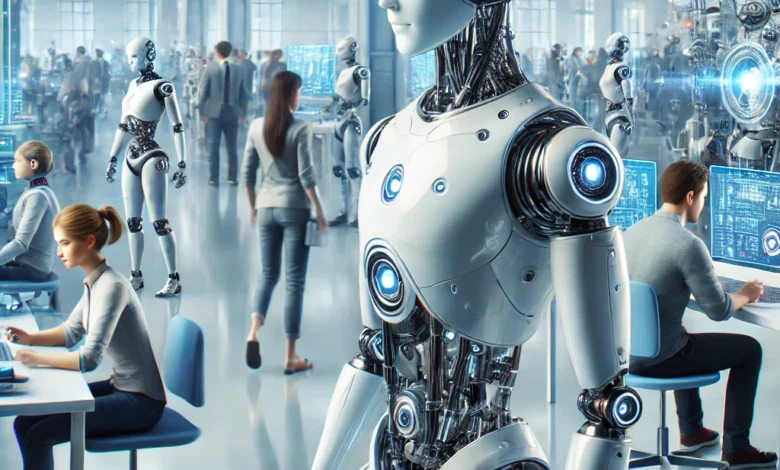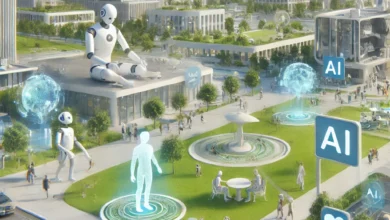Humanoid Robotics: Embracing a Future of Collaboration and Innovation

Introduction
The concept of humanoid robotics has evolved significantly over the past few decades. What once existed only in the realm of science fiction is now becoming an integral part of our daily lives. Humanoid robots, designed to resemble and interact like humans, are increasingly being integrated into various sectors, from healthcare and education to manufacturing and customer service. These robots are not merely tools or machines; they represent a future where humans and robots work together harmoniously to achieve greater efficiency, innovation, and well-being. This blog explores the positive impact of humanoid robotics on society, highlighting the potential benefits and opportunities that come with their integration.
The Evolution of Humanoid Robotics
The journey of humanoid robotics began with simple automata that could mimic basic human actions. Over time, advancements in artificial intelligence, machine learning, and robotics have allowed for the development of robots that can perform complex tasks, communicate effectively, and even exhibit emotional intelligence. Modern humanoid robots are equipped with advanced sensors, cameras, and processors that enable them to perceive and understand their environment. They can recognize faces, detect emotions, and respond appropriately, making them invaluable companions and assistants in various settings.
Key Milestones in Humanoid Robotics
- Early Automata: The roots of humanoid robotics can be traced back to ancient times when inventors created mechanical figures that could mimic human actions. These early automata laid the foundation for future developments in robotics.
- First Humanoid Robots: The 20th century saw the creation of the first true humanoid robots. These machines were rudimentary but marked a significant step towards more advanced designs.
- AI Integration: The integration of artificial intelligence into robotics allowed humanoid robots to learn from their environment, adapt to new situations, and improve their performance over time.
- Emotional AI: Recent advancements have led to the development of robots that can recognize and respond to human emotions, enhancing their ability to interact with people in a meaningful way.
Applications of Humanoid Robots in Various Sectors
Humanoid robots are not confined to a single industry; their versatility makes them valuable across multiple sectors. From healthcare to education, these robots are revolutionizing the way we approach tasks and challenges, leading to improved outcomes and new possibilities.
Healthcare
In healthcare, humanoid robots are transforming patient care and medical procedures. These robots can assist in surgeries, providing precision and consistency that surpass human capabilities. They also serve as companions for patients, particularly the elderly or those with disabilities. By offering companionship, reminding patients to take their medications, and even monitoring vital signs, humanoid robots contribute to better health outcomes and improved quality of life.
Examples of Humanoid Robots in Healthcare:
- Robotic Surgeons: Advanced robots are being used to perform minimally invasive surgeries with greater accuracy and less recovery time for patients.
- Elderly Care Companions: Humanoid robots provide social interaction and support to elderly individuals, reducing feelings of loneliness and assisting with daily tasks.
- Rehabilitation: Robots are used in physical therapy to help patients recover from injuries by guiding them through exercises with precision.
Education
The education sector has also benefited from the integration of humanoid robots. These robots can serve as teaching assistants, providing personalized instruction and support to students. They can adapt to individual learning styles, offer additional help to struggling students, and even assist in teaching complex subjects through interactive and engaging methods. The presence of humanoid robots in classrooms encourages student engagement and enhances the learning experience.
Examples of Humanoid Robots in Education:
- Interactive Teaching Assistants: Robots help teachers by taking over routine tasks and providing additional support to students who need it.
- Language Learning: Humanoid robots can assist in teaching new languages by engaging students in conversation and correcting their pronunciation.
- Special Education: These robots are particularly beneficial in special education settings, where they can provide consistent and patient support to students with learning disabilities.
Manufacturing
In the manufacturing industry, humanoid robots are being used to automate complex tasks that require dexterity, precision, and consistency. These robots can work alongside human employees, taking on repetitive or dangerous tasks while allowing humans to focus on more strategic and creative aspects of production. The collaboration between humans and robots leads to increased efficiency, reduced error rates, and higher overall productivity.
Examples of Humanoid Robots in Manufacturing:
- Assembly Line Automation: Humanoid robots take on repetitive tasks on the assembly line, reducing the likelihood of human error.
- Quality Control: These robots can inspect products with a level of precision that surpasses human capabilities, ensuring higher quality standards.
- Collaborative Robots (Cobots): Humanoid robots work alongside human employees, complementing their skills and increasing overall productivity.
Customer Service
Humanoid robots are also making their mark in the customer service industry. With the ability to interact with customers, answer questions, and provide assistance, these robots are becoming valuable assets in retail, hospitality, and other service-oriented industries. They can handle multiple customer interactions simultaneously, offer 24/7 support, and provide consistent and accurate information.
Examples of Humanoid Robots in Customer Service:
- Retail Assistants: Humanoid robots greet customers, provide information about products, and assist with purchasing decisions.
- Hotel Concierge: In the hospitality industry, robots serve as concierges, helping guests with check-in, room service, and local information.
- Banking Assistants: Humanoid robots assist customers in banks, helping them with transactions and answering questions about services.
The Ethical and Social Implications of Humanoid Robotics
While the benefits of humanoid robotics are undeniable, their integration into society also raises important ethical and social questions. As these robots become more advanced and capable, it is crucial to consider the implications of their widespread use.
Job Displacement
One of the primary concerns surrounding humanoid robotics is the potential for job displacement. As robots take on tasks traditionally performed by humans, there is a fear that certain jobs may become obsolete. However, it is important to recognize that the rise of robotics also creates new opportunities. The development, maintenance, and programming of humanoid robots require a highly skilled workforce, leading to the creation of new jobs in these areas. Additionally, robots can take over dangerous or monotonous tasks, allowing humans to focus on more fulfilling and creative work.
Privacy and Security
As humanoid robots become more integrated into our lives, concerns about privacy and security also arise. These robots often collect and process large amounts of data, which could be vulnerable to hacking or misuse. Ensuring that robust security measures are in place and that data is handled responsibly is essential to maintaining trust in humanoid robotics.
Human-Robot Interaction
The way humans interact with robots will play a significant role in the acceptance and success of humanoid robotics. It is crucial to design robots that are not only functional but also socially aware and empathetic. Building robots that can understand and respond to human emotions will enhance their ability to integrate into society and work alongside humans effectively.
The Future of Humanoid Robotics
The future of humanoid robotics is bright, with endless possibilities for innovation and collaboration. As technology continues to advance, we can expect to see even more sophisticated and capable humanoid robots entering various sectors. These robots will not only enhance productivity and efficiency but also contribute to a more inclusive and supportive society.
In the coming years, we may witness the development of humanoid robots that can perform tasks currently unimaginable. From exploring distant planets to providing companionship to those in need, the potential applications of these robots are limitless. The key to unlocking this potential lies in responsible innovation, ethical considerations, and a commitment to enhancing human life through technology.
Conclusion
Humanoid robotics represents a significant step forward in the evolution of technology and its integration into our daily lives. By working alongside humans, these robots have the potential to revolutionize industries, improve quality of life, and drive innovation. While challenges remain, the positive impact of humanoid robotics is undeniable. As we move forward, it is essential to embrace this technology with an open mind and a focus on collaboration, ensuring that the future of humanoid robotics is one of progress, inclusivity, and shared success.



